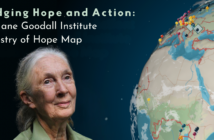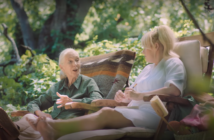This story comes from another dark chapter in human history. A recent horror, which all but young children will remember. A day in 2001 when the World Trade Center was attacked, when the Twin Towers fell, when the world changed forever. I was in New York on that terrible day, traveling with my friend and JGI colleague Mary Lewis, We were staying in mid-Manhattan at the Roger Smith Hotel. First came the confused reporting from the television screen. Then another colleague arrived, white and shaken. She had been on the very last plane to land before the airport closed, and she actually saw, from the taxi, the plane crashing into the second tower.
Disbelief. Fear. Confusion. And then the city went gradually silent until all we could hear was the sound of police-car sirens and the wailing of ambulances. People disappeared from the streets. It was a ghost town, unreal. There were times when I felt I was living in a dream.
It was eight days before there was a plane on which we could leave. Eight days during which the city remained quiet and fear gave way to grief, anguish – and eventually, as the facts emerged, anger. Mary and I met with our Arab and Muslim friends, desperate to try to help them face the terrible backlash that we predicted would be directed against hundreds of innocent people. And all the while we could see the haze over what had been the Trade Center, and we could smell death.
Ironically, when Mary and I finally left, we were flying to Portland, Oregon, where I had to give a talk to a boys’ secondary school, a talk entitled “Reason for Hope.” It was, without doubt, the hardest lecture I have ever had to give. For where was hope at that time? Only when I was actually talking, looking out over all the young, bewildered faces, could I find the things to say, drawing on the terrible events of history, how they had passed, how we humans always find reserves of strength and courage to overcome that which fate throws our way.
Just over 10 years after 9/11, on a cool, sunny April morning in 2012, I went to meet “Survivor”, a Callery pear tree, and the three Vega, and Richie Cabo. We met outside the new 9/11 Memorial at what was once known as Ground Zero, and went through the tight security together. I could hardly believe that, finally, I was going to meet this incredible tree.
In the 1970s she had been placed in a planter near Building 5 of the World Trade Center, and each year her delicate white blossoms had brought a touch of spring into a world of concrete. In 2001, after the 9/11 attack, this tree, like all the other trees that had been planted there, disappeared beneath the fallen towers.
But amazingly, in October, a cleanup worker found her, smashed and pinned between blocks of cement. The discovery was reported to Bram Gunther, who was then deputy director of forestry for the NYC Parks Department, and when he arrived, he initially thought the tree was unsalvageable. She had been decapitated and the eight feet of trunk that remained were charred black, the roots were broken, and there was only one living branch.
Bram told me how, as he looked at the stricken tree, he was skeptical at first, but ultimately the cleanup workers persuaded him to give the tree a chance. And so he ordered that she be sent off to the Parks Department’s nursery in Van Cortlandt Park in the Bronx.
Ron Vega, now the director of design for the 9/11 Memorial site, was a cleanup worker back then. He smiled as he thought back to that time. “ A lot of people thought it was a wasted effort to try to rescue her,” he recalled. “So she was taken out of the site almost clandestinely – under the cover of night.”
As we walked toward this special tree, on that special April day, I felt as much in awe as if I were going to meet one of the great spiritual leaders or shamans.
She is not spectacular to look at – not until you realize what she has been through and understand the miracle of her survival. We stood together outside the protective railing. We reached out to gently touch the ends of her branches. Many of us, perhaps all, had tears in our eyes – my own eyes were too blurred to be sure.
Richie Cabo, the nursery manager, who became one of Survivor’s principal caregivers, told me that when he first saw the decapitated tree, he did not think anything could save her. But once the dead, burned tissues had been cut away and her trimmed roots deeply planted in good, rich soil, Survivor proved him wrong.
“In time,” said Richie, “she took care of herself. We like to say she got tough from being in the Bronx!” But in the beginning, with all the fertilizing and pruning, it was hard work. And during this time all the staff became very attached to Survivor, for she symbolized endurance and resilience. In particular a special bond grew up between the tree and Richie. “She became dear to me,” he said.
This blog post is taken from an excerpt in Dr. Goodall’s book, “Seeds of Hope: Wisdom and Wonder from the World of Plants”.

The Jane Goodall Institute is a global community conservation organization that advances the vision and work of Dr. Jane Goodall. By protecting chimpanzees and inspiring people to conserve the natural world we all share, we improve the lives of people, animals and the environment. Everything is connected—everyone can make a difference.









